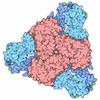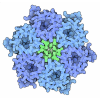+ Open data
Open data
- Basic information
Basic information
| Entry | Database: PDB / ID: 8z40 | ||||||
|---|---|---|---|---|---|---|---|
| Title | The structure of type III CRISPR-associated deaminase apo form | ||||||
 Components Components | Adenosine deaminase domain-containing protein | ||||||
 Keywords Keywords | IMMUNE SYSTEM / defense system / deaminase | ||||||
| Function / homology | inosine biosynthetic process / Adenosine deaminase domain / Adenosine deaminase / adenosine catabolic process / adenosine deaminase activity / Adenosine/adenine deaminase / Metal-dependent hydrolase / Adenosine deaminase domain-containing protein Function and homology information Function and homology information | ||||||
| Biological species |  Limisphaera ngatamarikiensis (bacteria) Limisphaera ngatamarikiensis (bacteria) | ||||||
| Method | ELECTRON MICROSCOPY / single particle reconstruction / cryo EM / Resolution: 3.26 Å | ||||||
 Authors Authors | Chen, M.R. / Li, Z.X. / Xiao, Y.B. | ||||||
| Funding support |  China, 1items China, 1items
| ||||||
 Citation Citation |  Journal: Science / Year: 2024 Journal: Science / Year: 2024Title: Antiviral signaling of a type III CRISPR-associated deaminase. Authors: Yutao Li / Zhaoxing Li / Purui Yan / Chenyang Hua / Jianping Kong / Wanqian Wu / Yurong Cui / Yan Duan / Shunxiang Li / Guanglei Li / Shunli Ji / Yijun Chen / Yucheng Zhao / Peng Yang / ...Authors: Yutao Li / Zhaoxing Li / Purui Yan / Chenyang Hua / Jianping Kong / Wanqian Wu / Yurong Cui / Yan Duan / Shunxiang Li / Guanglei Li / Shunli Ji / Yijun Chen / Yucheng Zhao / Peng Yang / Chunyi Hu / Meiling Lu / Meirong Chen / Yibei Xiao /   Abstract: Prokaryotes have evolved diverse defense strategies against viral infection, such as foreign nucleic acid degradation by CRISPR-Cas systems and DNA/RNA synthesis inhibition via nucleotide pool ...Prokaryotes have evolved diverse defense strategies against viral infection, such as foreign nucleic acid degradation by CRISPR-Cas systems and DNA/RNA synthesis inhibition via nucleotide pool depletion. Here, we report an antiviral mechanism of type III CRISPR-Cas-regulated ATP depletion, where ATP is converted into ITP by CRISPR-Cas-associated adenosine deaminase (CAAD) upon activation by either cA or cA, followed by hydrolysis into IMP by Nudix hydrolase, ultimately resulting in cell growth arrest. The cryo-electron microscopy structures of CAAD in its apo and activated forms, together with biochemical evidence, revealed how cA/cA binds to the CARF domain and abrogates CAAD autoinhibition, inducing substantial conformational changes that reshape the structure of CAAD and induce its deaminase activity. Our results reveal the mechanism of a CRISPR-Cas-regulated ATP depletion antiviral strategy. | ||||||
| History |
|
- Structure visualization
Structure visualization
| Structure viewer | Molecule:  Molmil Molmil Jmol/JSmol Jmol/JSmol |
|---|
- Downloads & links
Downloads & links
- Download
Download
| PDBx/mmCIF format |  8z40.cif.gz 8z40.cif.gz | 536.3 KB | Display |  PDBx/mmCIF format PDBx/mmCIF format |
|---|---|---|---|---|
| PDB format |  pdb8z40.ent.gz pdb8z40.ent.gz | 442 KB | Display |  PDB format PDB format |
| PDBx/mmJSON format |  8z40.json.gz 8z40.json.gz | Tree view |  PDBx/mmJSON format PDBx/mmJSON format | |
| Others |  Other downloads Other downloads |
-Validation report
| Summary document |  8z40_validation.pdf.gz 8z40_validation.pdf.gz | 412.6 KB | Display |  wwPDB validaton report wwPDB validaton report |
|---|---|---|---|---|
| Full document |  8z40_full_validation.pdf.gz 8z40_full_validation.pdf.gz | 442.9 KB | Display | |
| Data in XML |  8z40_validation.xml.gz 8z40_validation.xml.gz | 52.4 KB | Display | |
| Data in CIF |  8z40_validation.cif.gz 8z40_validation.cif.gz | 79.2 KB | Display | |
| Arichive directory |  https://data.pdbj.org/pub/pdb/validation_reports/z4/8z40 https://data.pdbj.org/pub/pdb/validation_reports/z4/8z40 ftp://data.pdbj.org/pub/pdb/validation_reports/z4/8z40 ftp://data.pdbj.org/pub/pdb/validation_reports/z4/8z40 | HTTPS FTP |
-Related structure data
| Related structure data |  39759MC  8z3kC  8z3pC  8z3rC M: map data used to model this data C: citing same article ( |
|---|---|
| Similar structure data | Similarity search - Function & homology  F&H Search F&H Search |
- Links
Links
- Assembly
Assembly
| Deposited unit | 
|
|---|---|
| 1 |
|
- Components
Components
| #1: Protein | Mass: 70859.859 Da / Num. of mol.: 6 Source method: isolated from a genetically manipulated source Source: (gene. exp.)  Limisphaera ngatamarikiensis (bacteria) Limisphaera ngatamarikiensis (bacteria)Gene: G4L39_03315 / Production host:  Has protein modification | N | |
|---|
-Experimental details
-Experiment
| Experiment | Method: ELECTRON MICROSCOPY |
|---|---|
| EM experiment | Aggregation state: PARTICLE / 3D reconstruction method: single particle reconstruction |
- Sample preparation
Sample preparation
| Component | Name: CRISPR-associated adenosine deaminase / Type: COMPLEX / Entity ID: all / Source: RECOMBINANT |
|---|---|
| Source (natural) | Organism:  Limisphaera ngatamarikiensis (bacteria) Limisphaera ngatamarikiensis (bacteria) |
| Source (recombinant) | Organism:  |
| Buffer solution | pH: 7.5 |
| Specimen | Embedding applied: NO / Shadowing applied: NO / Staining applied: NO / Vitrification applied: YES |
| Vitrification | Cryogen name: ETHANE |
- Electron microscopy imaging
Electron microscopy imaging
| Experimental equipment |  Model: Titan Krios / Image courtesy: FEI Company |
|---|---|
| Microscopy | Model: FEI TITAN KRIOS |
| Electron gun | Electron source:  FIELD EMISSION GUN / Accelerating voltage: 300 kV / Illumination mode: FLOOD BEAM FIELD EMISSION GUN / Accelerating voltage: 300 kV / Illumination mode: FLOOD BEAM |
| Electron lens | Mode: BRIGHT FIELD / Nominal defocus max: 2400 nm / Nominal defocus min: 800 nm |
| Image recording | Electron dose: 40 e/Å2 / Film or detector model: FEI FALCON IV (4k x 4k) |
- Processing
Processing
| CTF correction | Type: PHASE FLIPPING AND AMPLITUDE CORRECTION | ||||||||||||||||||||||||
|---|---|---|---|---|---|---|---|---|---|---|---|---|---|---|---|---|---|---|---|---|---|---|---|---|---|
| 3D reconstruction | Resolution: 3.26 Å / Resolution method: FSC 0.143 CUT-OFF / Num. of particles: 247410 / Symmetry type: POINT | ||||||||||||||||||||||||
| Refine LS restraints |
|
 Movie
Movie Controller
Controller

















 PDBj
PDBj

